ITRouter_issue01
- 格式:pdf
- 大小:8.59 MB
- 文档页数:81
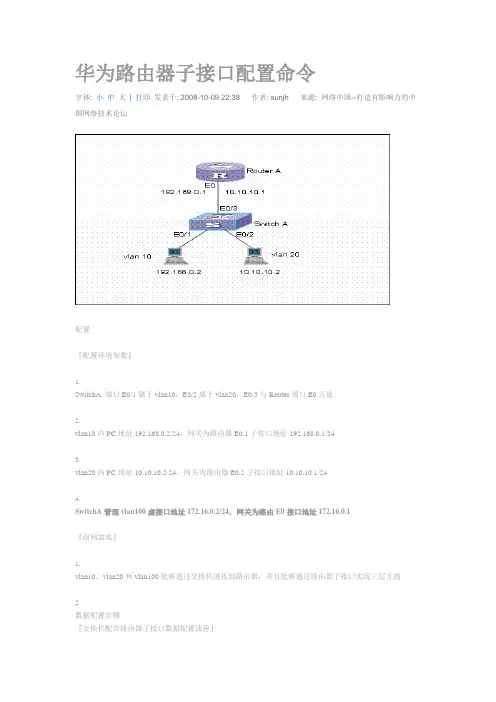
华为路由器子接口配置命令字体: 小中大| 打印发表于: 2008-10-09 22:38 作者: sunjh 来源: 网络中国--打造有影响力的中国网络技术论坛配置『配置环境参数』1.SwitchA 端口E0/1属于vlan10,E0/2属于vlan20,E0/3与Router端口E0互连2.vlan10内PC地址192.168.0.2/24,网关为路由器E0.1子接口地址192.168.0.1/243.vlan20内PC地址10.10.10.2/24,网关为路由器E0.2子接口地址10.10.10.1/244.SwitchA管理vlan100虚接口地址172.16.0.2/24,网关为路由E0接口地址172.16.0.1『组网需求』1.vlan10、vlan20和vlan100能够通过交换机透传到路由器,并且能够通过路由器子接口实现三层互通2数据配置步骤『交换机配合路由器子接口数据配置流程』一般来说交换机与路由器子接口配合,都因为交换机是二层交换机,没有三层路由功能,通过路由器终结二层交换机透传过来的vlan数据包,实现三层互通,是此类组网的主要目的。
在路由器子接口之间,各个网段之间为直连路由,如果要实现某些网段之间的访问控制,一般通过在路由器上配置访问控制列表来实现。
三层交换机由于本身支持多个虚接口,可以直接实现多网段之间的三层互通,一般不涉及此类组网。
【SwitchA相关配置】1.创建(进入)vlan10[SwitchA] vlan 102.将E0/1加入到vlan10[SwitchA-vlan10]port Ethernet 0/13.创建(进入)vlan20[SwitchA]vlan 204.将E0/2加入到vlan20[SwitchA-vlan20]port Ethernet 0/25.实际当中一般将上行端口设置成trunk属性,允许vlan透传int e0/3[SwitchA-Ethernet0/3]port link-type trunk6.允许所有的vlan从E0/3端口透传通过,也可以指定具体的vlan值[SwitchA-Ethernet0/3]port trunk permit vlan all7.创建(进入)vlan100[SwitchA]vlan 1008.vlan100可以不包含具体的端口9.创建(进入)vlan100的虚接口[SwitchA]interface Vlan-interface 10010.给vlan100的虚接口配置IP地址[SwitchA-Vlan-interface100]ip address 172.16.0.2 255.255.255.011.设置E0/3端口PVID为100,将管理vlan100送出去的报文vlan标记剥去,送往路由器主接口[SwitchA-Ethernet0/3]port trunk pvid vlan 10012.如果需要允许其它网段与交换机管理vlan地址互通,需要配置一条默认路由[SwitchA]ip route-static 0.0.0.0 0.0.0.0 172.16.0.1【RouterA相关配置】1.创建(进入)E0.1子接口[RouterA]inter Ethernet 0.12.在E0.1子接口里封装vlan10[RouterA-Ethernet0.1]vlan-type dot1q vid 103.在E0.1子接口配置IP地址[RouterA-Ethernet0.1]ip address 192.168.0.1 255.255.255.04.创建(进入)E0.2子接口[RouterA]inter Ethernet 0.2在E0.2子接口里封装vlan20[RouterA-Ethernet0.2]vlan-type dot1q vid 206.在E0.2子接口配置IP地址[RouterA-Ethernet0.2]ip address 10.10.10.1 255.255.255.07.进入E0接口[SwitchB-vlan20]port Ethernet 0[RouterA-Ethernet0]ip address 172.16.0.1 255.255.255.0【补充说明】1.如果一个端口是trunk端口,则该端口可以属于多个vlan2.缺省情况下trunk端口的PVID为1,可以在端口模式下通过命令port trunk pvid vlan vlanid 来修改端口的PVID3.一台交换机上如果已经设置了某个端口为hybrid端口,则不可以再把另外的端口设置为trunk端口3测试验证1.PC都能PING通自己的网关2.PC之间能够PING通3.交换机能够与路由器E0接口地址互通华为路由器交换机配置命令:计算机命令PCAlogin:root;使用root用户password:linux;口令是linux#shutdown-hnow;关机#init0;关机#logout;用户注销#login;用户登录#ifconfig;显示IP地址#ifconfigeth0netmask;设置IP地址#ifconfigeht0netmaskdown;禁用IP地址#routeadd0.0.0.0gw;设置网关#routedel0.0.0.0gw;删除网关#routeadddefaultgw;设置网关#routedeldefaultgw;删除网关#route;显示网关#ping;发ECHO包#telnet;远程登录华为路由器交换机配置命令:交换机命令[Quidway]discur;显示当前配置[Quidway]displaycurrent-configuration;显示当前配置[Quidway]displayinterfaces;显示接口信息[Quidway]displayvlanall;显示路由信息[Quidway]displayversion;显示版本信息[Quidway]superpassword;修改特权用户密码[Quidway]sysname;交换机命名[Quidway]interfaceethernet0/1;进入接口视图[Quidway]interfacevlanx;进入接口视图[Quidway-Vlan-interfacex]ipaddress10.65.1.1255.255.0.0;配置VLAN的IP地址[Quidway]iproute-static0.0.0.00.0.0.010.65.1.2;静态路由=网关[Quidway]rip;三层交换支持[Quidway]local-userftp[Quidway]user-interfacevty04;进入虚拟终端[S3026-ui-vty0-4]authentication-modepassword;设置口令模式[S3026-ui-vty0-4]setauthentication-modepasswordsimple222;设置口令[S3026-ui-vty0-4]userprivilegelevel3;用户级别[Quidway]interfaceethernet0/1;进入端口模式[Quidway]inte0/1;进入端口模式[Quidway-Ethernet0/1]duplex{half|full|auto};配置端口工作状态[Quidway-Ethernet0/1]speed{10|100|auto};配置端口工作速率[Quidway-Ethernet0/1]flow-control;配置端口流控[Quidway-Ethernet0/1]mdi{across|auto|normal};配置端口平接扭接[Quidway-Ethernet0/1]portlink-type{trunk|access|hybrid};设置端口工作模式[Quidway-Ethernet0/1]portaccessvlan3;当前端口加入到VLAN[Quidway-Ethernet0/2]porttrunkpermitvlan{ID|All};设trunk允许的VLAN [Quidway-Ethernet0/3]porttrunkpvidvlan3;设置trunk端口的PVID [Quidway-Ethernet0/1]undoshutdown;激活端口[Quidway-Ethernet0/1]shutdown;关闭端口[Quidway-Ethernet0/1]quit;返回[Quidway]vlan3;创建VLAN[Quidway-vlan3]portethernet0/1;在VLAN中增加端口[Quidway-vlan3]porte0/1;简写方式[Quidway-vlan3]portethernet0/1toethernet0/4;在VLAN中增加端口[Quidway-vlan3]porte0/1toe0/4;简写方式[Quidway]monitor-port;指定镜像端口[Quidway]portmirror;指定被镜像端口[Quidway]portmirrorint_listobserving-portint_typeint_num;指定镜像和被镜像[Quidway]descriptionstring;指定VLAN描述字符[Quidway]description;删除VLAN描述字符[Quidway]displayvlan[vlan_id];查看VLAN设置[Quidway]stp{enable|disable};设置生成树,默认关闭[Quidway]stppriority4096;设置交换机的优先级[Quidway]stproot{primary|secondary};设置为根或根的备份[Quidway-Ethernet0/1]stpcost200;设置交换机端口的花费[Quidway]link-aggregatione0/1toe0/4ingress|both;端口的聚合[Quidway]undolink-aggregatione0/1|all;始端口为通道号[SwitchA-vlanx]isolate-user-vlanenable;设置主vlan[SwitchA]isolate-user-vlansecondary;设置主vlan包括的子vlan [Quidway-Ethernet0/2]porthybridpvidvlan;设置vlan的pvid[Quidway-Ethernet0/2]porthybridpvid;删除vlan的pvid[Quidway-Ethernet0/2]porthybridvlanvlan_id_listuntagged;设置无标识的vlan 如果包的vlanid与PVId一致,则去掉vlan信息.默认PVID=1。
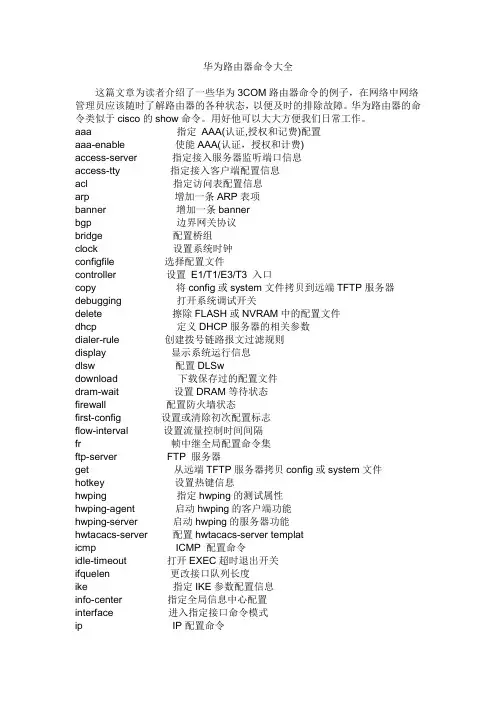
华为路由器命令大全这篇文章为读者介绍了一些华为3COM路由器命令的例子,在网络中网络管理员应该随时了解路由器的各种状态,以便及时的排除故障。
华为路由器的命令类似于cisco的show命令。
用好他可以大大方便我们日常工作。
aaa 指定AAA(认证,授权和记费)配置aaa-enable 使能AAA(认证,授权和计费)access-server 指定接入服务器监听端口信息access-tty 指定接入客户端配置信息acl 指定访问表配置信息arp 增加一条ARP表项banner 增加一条bannerbgp 边界网关协议bridge 配置桥组clock 设置系统时钟configfile 选择配置文件controller 设置E1/T1/E3/T3 入口copy 将config或system文件拷贝到远端TFTP服务器debugging 打开系统调试开关delete 擦除FLASH或NVRAM中的配置文件dhcp 定义DHCP服务器的相关参数dialer-rule 创建拨号链路报文过滤规则display 显示系统运行信息dlsw 配置DLSwdownload 下载保存过的配置文件dram-wait 设置DRAM等待状态firewall 配置防火墙状态first-config 设置或清除初次配置标志flow-interval 设置流量控制时间间隔fr 帧中继全局配置命令集ftp-server FTP 服务器get 从远端TFTP服务器拷贝config或system文件hotkey 设置热键信息hwping 指定hwping的测试属性hwping-agent 启动hwping的客户端功能hwping-server 启动hwping的服务器功能hwtacacs-server 配置hwtacacs-server templaticmp ICMP 配置命令idle-timeout 打开EXEC超时退出开关ifquelen 更改接口队列长度ike 指定IKE参数配置信息info-center 指定全局信息中心配置interface 进入指定接口命令模式ip IP配置命令ipsec 指定IPSec相关参数配置信息ipx 全局IPX配置命令子集isdn 全局ISDN配置命令l2tp 设置L2TPl2tp-group 指定L2TP组配置信息language 语言模式切换leased-modem 启动或关闭专线modemlocal-user 指定向系统中加入用户的配置信息logic-channel 配置逻辑通道login-method 指定login使用方法列表logout 退出multicast 指定组播配置信息nat 配置地址转换ntp-service NTP模块ospf 开放最短路径优先协议pad 远程登录功能pim 协议独立组播ping 检查网络主机连接及主机是否可达pos-server POS接入服务器ppp 指定ppp配置信息printer 配置LPD网络打印机protocol 设置系统支持的协议qos 服务质量命令radius 指定RADIUS配置信息reboot 按某些条件重启路由器reset 执行清除操作reverse-telnet 设置反向telnet参数rip 路由信息协议route-policy 指定一个策略集合router 进入路由处理模式rsa 指定RSA模块配置信息save 将当前配置参数保存至FLASH或NVRAM中-string 配置modem拨号脚本send 向其他终端发送一条消息settr 设置时间范围snmp-agent 指定SNMP配置参数sot 配置全局SOT参数ssh 设置ssh的属性standby 设置动态路由备份属性subscriber-line 语音接口配置sysname 修改系统名称tcp 配置全局TCP参数telnet 远程登录功能terminal 指定terminal termplate的配置信息timerange 启动或关闭时间区域tracert 跟踪到目的地经过了哪些路由器translate 配置X2T(X25-To-Tcp) 路由表tty 指定终端接入全局设置tty-app 指定终端接入应用设置undo 取消命令操作或恢复为缺省值update 在线升级接口板驱动程序userlog 用户日志version 确认配置VRP版本号和将当前VRP的版本是否相同voice-setup 语音特性设置vrrp 使能ping虚拟地址开关x25 X.25协议分组层x29 指定X29配置信息华为交换机命令大全[Quidway]dis cur ;显示当前配置[Quidway]display current-configuration ;显示当前配置[Quidway]display interfaces ;显示接口信息[Quidway]display vlan all ;显示路由信息[Quidway]display version ;显示版本信息[Quidway]super password ;修改特权用户密码[Quidway]sysname ;交换机命名[Quidway]interface ethernet 0/1 ;进入接口视图[Quidway]interface vlan x ;进入接口视图[Quidway-Vlan-interfacex]ip address 10.65.1.1 255.255.0.0 ;配置VLAN 的IP地址[Quidway]ip route-static 0.0.0.0 0.0.0.0 10.65.1.2 ;静态路由=网关[Quidway]rip ;三层交换支持[Quidway]local-user ftp[Quidway]user-interface vty 0 4 ;进入虚拟终端[S3026-ui-vty0-4]authentication-mode password ;设置口令模式[S3026-ui-vty0-4]set authentication-mode password simple 222 ;设置口令[S3026-ui-vty0-4]user privilege level 3 ;用户级别[Quidway]interface ethernet 0/1 ;进入端口模式[Quidway]int e0/1 ;进入端口模式[Quidway-Ethernet0/1]duplex {half|full|auto} ;配置端口工作状态[Quidway-Ethernet0/1]speed {10|100|auto} ;配置端口工作速率[Quidway-Ethernet0/1]flow-control ;配置端口流控[Quidway-Ethernet0/1]mdi {across|auto|normal} ;配置端口平接扭接[Quidway-Ethernet0/1]port link-type {trunk|access|hybrid} ;设置端口工作模式[Quidway-Ethernet0/1]port access vlan 3 ;当前端口加入到VLAN[Quidway-Ethernet0/2]port trunk permit vlan {ID|All} ;设trunk允许的VLAN[Quidway-Ethernet0/3]port trunk pvid vlan 3 ;设置trunk端口的PVID[Quidway-Ethernet0/1]undo shutdown ;激活端口[Quidway-Ethernet0/1]shutdown ;关闭端口[Quidway-Ethernet0/1]quit ;返回[Quidway]vlan 3 ;创建VLAN[Quidway-vlan3]port ethernet 0/1 ;在VLAN 中增加端口[Quidway-vlan3]port e0/1 ;简写方式[Quidway-vlan3]port ethernet 0/1 to ethernet 0/4 ;在VLAN中增加端口[Quidway-vlan3]port e0/1 to e0/4 ;简写方式[Quidway]monitor-port <interface_type interface_num> ;指定镜像端口[Quidway]port mirror <interface_type interface_num> ;指定被镜像端口[Quidway]port mirror int_list observing-port int_type int_num ;指定镜像和被镜像[Quidway]description string ;指定VLAN描述字符[Quidway]description ;删除VLAN描述字符[Quidway]display vlan [vlan_id] ;查看VLAN 设置[Quidway]stp {enable|disable} ;设置生成树,默认关闭[Quidway]stp priority 4096 ;设置交换机的优先级[Quidway]stp root {primary|secondary} ;设置为根或根的备份[Quidway-Ethernet0/1]stp cost 200 ;设置交换机端口的花费[Quidway]link-aggregation e0/1 to e0/4 ingress|both ;端口的聚合[Quidway]undo link-aggregation e0/1|all ; 始端口为通道号[SwitchA-vlanx]isolate-user-vlan enable ;设置主vlan [SwitchA]isolate-user-vlan <x> secondary <list> ;设置主vlan 包括的子vlan[Quidway-Ethernet0/2]port hybrid pvid vlan <id> ;设置vlan的pvid[Quidway-Ethernet0/2]port hybrid pvid ;删除vlan 的pvid[Quidway-Ethernet0/2]port hybrid vlan vlan_id_list untagged ;设置无标识的vlan如果包的vlan id与PVId一致,则去掉vlan信息. 默认PVID=1。

声明Copyright © 2021 普联技术有限公司版权所有,保留所有权利未经普联技术有限公司明确书面许可,任何单位或个人不得擅自仿制、复制、誊抄或转译本手册部分或全部内容,且不得以营利为目的进行任何方式(电子、影印、录制等)的传播。
为普联技术有限公司注册商标。
本手册提及的所有商标,由各自所有人拥有。
本手册所提到的产品规格和资讯仅供参考,如有内容更新,恕不另行通知。
除非有特殊约定,本手册仅作为使用指导,所作陈述均不构成任何形式的担保。
目录第1章前言 (1)1.1 目标读者 (1)1.2 本书约定 (1)1.3 适用机型 (1)第2章基础联网设置 (3)2.1 企业路由器基本设置指南 (3)2.1.1 应用介绍 (3)2.1.2 需求介绍 (3)2.1.3 设置方法 (3)2.1.4 注意事项 (7)2.2 企业路由器IPv6上网配置指导 (8)2.2.1 应用介绍 (8)2.2.2 需求介绍 (8)2.2.3 设置方法 (8)2.2.4 疑问解答 (15)第3章设备管理 (17)3.1 如何在外网远程管理(控制)路由器? (17)3.1.1 应用介绍 (17)3.1.2 需求介绍 (17)3.1.3 设置方法 (17)3.1.4 注意事项 (20)3.1.5 疑问解答 (21)3.2 如何设置自动重启? (22)3.2.1 应用介绍 (22)3.2.2 需求介绍 (22)3.2.3 设置方法 (22)3.2.4 注意事项 (23)第4章负载均衡 (24)4.1 多WAN口路由器负载均衡的设置指南 (24)4.1.1 应用介绍 (24)4.1.2 需求介绍 (24)4.1.3 工作原理 (24)4.1.4 设置方法 (25)第5章路由转发模块 (27)5.1 策略路由设置指南 (27)5.1.1 应用介绍 (27)5.1.2 需求介绍 (27)5.1.3 设置方法 (28)5.1.4 疑问解答 (31)5.2 ISP选路设置指南 (33)5.2.1 应用介绍 (33)5.2.2 需求介绍 (33)5.2.3 设置方法 (34)5.3 静态路由设置指南 (36)5.3.1 应用介绍 (36)5.3.2 需求介绍 (36)5.3.3 设置方法 (37)5.4 线路备份设置指南 (38)5.4.1 应用介绍 (38)5.4.2 需求介绍 (38)5.4.3 设置方法 (38)5.4.4 注意事项 (40)5.5 虚拟服务器设置指南 (41)5.5.1 应用介绍 (41)5.5.2 需求介绍 (41)5.5.3 设置方法 (42)5.5.4 疑问解答 (43)5.6 NAT-DMZ功能设置指南 (44)5.6.1 应用介绍 (44)5.6.2 需求介绍 (44)5.6.3 设置方法 (45)第6章AP和易展管理 (47)6.1 AP管理设置指南 (47)6.1.1 应用介绍 (47)6.1.2 需求介绍 (47)6.1.3 设置方法 (47)6.2 易展AP设置指南 (53)6.2.1 应用介绍 (53)6.2.2 需求介绍 (53)6.2.3 设置方法 (54)6.2.4 注意事项 (58)第7章行为管控 (59)7.1 连接数限制设置指南 (59)7.1.1 应用介绍 (59)7.1.2 需求介绍 (59)7.1.3 设置方法 (59)7.1.4 疑问解答 (60)7.2 访问控制设置指南 (61)7.2.1 应用介绍 (61)7.2.2 需求介绍 (61)7.2.3 设置方法 (61)7.2.4 疑问解答 (67)7.3 应用限制设置指南 (68)7.3.1 应用介绍 (68)7.3.2 需求介绍 (68)7.3.3 设置方法 (68)7.4 网址过滤设置指南 (71)7.4.1 应用介绍 (71)7.4.2 需求介绍 (71)7.4.3 设置方法 (71)7.4.4 疑问解答 (75)7.5 网页安全设置指南 (76)7.5.1 应用介绍 (76)7.5.2 需求介绍 (76)7.5.3 设置方法 (76)第8章安全防护 (78)8.1 ARP防护设置指南 (78)8.1.1 应用介绍 (78)8.1.2 需求介绍 (78)8.1.3 设置方法 (78)8.1.4 疑问解答 (84)8.2 MAC地址过滤设置指南 (86)8.2.1 应用介绍 (86)8.2.2 需求介绍 (86)8.2.3 设置方法 (86)第9章VPN模块 (88)9.1 IPSec VPN设置指南 (88)9.1.1 应用介绍 (88)9.1.2 需求介绍 (88)9.1.3 设置方法 (89)9.2 L2TP VPN设置指南 (96)9.2.1 应用介绍 (96)9.2.2 需求介绍 (96)9.2.3 设置方法 (97)9.3 PPTP VPN设置指南 (105)9.3.1 应用介绍 (105)9.3.2 需求介绍 (105)9.3.3 设置方法 (106)9.4 L2TP VPN代理上网设置指南 (115)9.4.1 应用介绍 (115)9.4.2 需求介绍 (115)9.4.3 设置方法 (115)9.5 PPTP VPN代理上网设置指南 (120)9.5.1 应用介绍 (120)9.5.2 需求介绍 (120)9.5.3 设置方法 (120)第10章认证管理 (125)10.1 一键上网设置指南 (125)10.1.1 应用介绍 (125)10.1.2 需求介绍 (125)10.1.3 设置方法 (126)10.2 短信认证设置指南 (130)10.2.1 应用介绍 (130)10.2.2 需求介绍 (130)10.2.3 设置方法 (131)10.3 Portal认证设置指南—使用内置WEB服务器和内置认证服务器 (136)10.3.1 应用介绍 (136)10.3.2 需求介绍 (136)10.3.3 设置方法 (137)10.4 Portal认证设置指南—使用内置WEB服务器和外部认证服务器 (141)10.4.1 应用介绍 (141)10.4.2 需求介绍 (141)10.4.3 设置方法 (142)10.5 Portal认证设置指南—使用外置WEB服务器和内置认证服务器 (146)10.5.1 应用介绍 (146)10.5.2 需求介绍 (146)10.5.3 设置方法 (147)10.6 Portal认证设置指南—使用外置WEB服务器和外置认证服务器 (150)10.6.1 应用介绍 (150)10.6.2 需求介绍 (150)10.6.3 设置方法 (151)10.7 免认证策略的使用方法 (154)10.7.1 应用介绍 (154)10.7.2 需求介绍 (154)10.7.3 设置方法 (155)10.8 Portal认证中,外部WEB服务器建立规范 (158)10.8.1 应用介绍 (158)10.8.2 流程规范 (159)第11章工业级特性 (163)11.1 如何使用工业级路由器? (163)11.1.1 产品介绍 (163)11.1.2 需求介绍 (163)11.1.3 设置方法 (164)第12章其它功能 (168)12.1 地址组的设置与管理 (168)12.1.1 应用介绍 (168)12.1.2 需求介绍 (168)12.1.3 设置方法 (168)12.1.4 疑问解答 (170)12.2 带宽控制设置指南 (172)12.2.1 应用介绍 (172)12.2.2 需求介绍 (172)12.2.3 设置方法 (172)12.2.4 疑问解答 (175)12.3 PPPOE服务器应用设置指南 (177)12.3.1 应用介绍 (177)12.3.2 需求介绍 (177)12.3.3 设置方法 (178)12.3.4 疑问解答 (181)12.4 网络唤醒功能使用指南 (183)12.4.1 应用介绍 (183)12.4.2 需求介绍 (183)12.4.3 设置方法 (183)12.5 诊断工具使用指南 (186)12.5.1 应用介绍 (186)12.5.2 需求介绍 (186)12.5.3 设置方法 (187)第1章前言本手册旨在帮助您正确使用R系列企业级路由器。
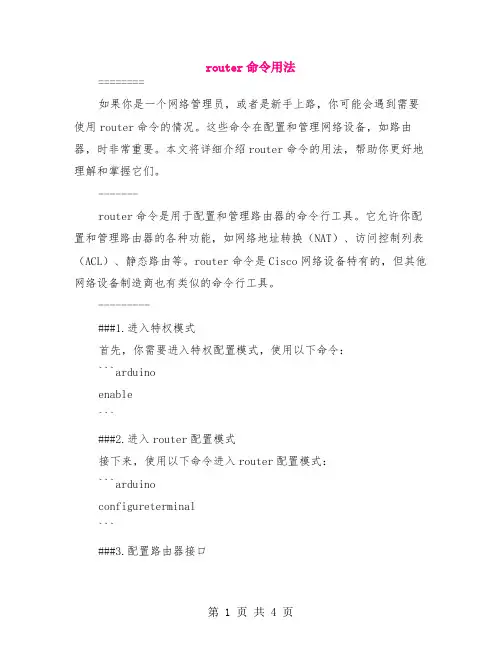
router命令用法========如果你是一个网络管理员,或者是新手上路,你可能会遇到需要使用router命令的情况。
这些命令在配置和管理网络设备,如路由器,时非常重要。
本文将详细介绍router命令的用法,帮助你更好地理解和掌握它们。
-------router命令是用于配置和管理路由器的命令行工具。
它允许你配置和管理路由器的各种功能,如网络地址转换(NAT)、访问控制列表(ACL)、静态路由等。
router命令是Cisco网络设备特有的,但其他网络设备制造商也有类似的命令行工具。
---------###1.进入特权模式首先,你需要进入特权配置模式,使用以下命令:```arduinoenable```###2.进入router配置模式接下来,使用以下命令进入router配置模式:```arduinoconfigureterminal```###3.配置路由器接口使用interface命令来配置路由器的接口。
例如,要配置一个名为"FastEthernet0/0"的接口,可以使用以下命令:```arduinointerfaceFastEthernet0/0```###4.配置静态路由使用static-route命令来配置静态路由。
例如,要添加一条将目标网络192.168.1.0/24路由到下一跳地址10.0.0.2的静态路由,可以使用以下命令:```arduinostaticroute192.168.1.0255.255.255.010.0.0.2```###5.保存配置并退出完成路由器的配置后,使用以下命令保存配置并退出:```csharpend```或者你可以直接按Ctrl+Z退出。
注意:请谨慎操作,一旦退出到用户模式,就无法再访问到路由器配置了。
务必记住你之前做过的所有设置,以防出现错误。
三、常见router命令示例----------###1.查看路由表信息使用以下命令可以查看路由表信息:```arduinoshowiproute```###2.删除静态路由使用以下命令可以删除指定的静态路由:```arduinonostaticroute<目标网络/掩码><下一跳地址>```四、常见问题及解决方案----------在使用router命令时,可能会出现一些常见问题,例如接口配置错误、配置丢失等。
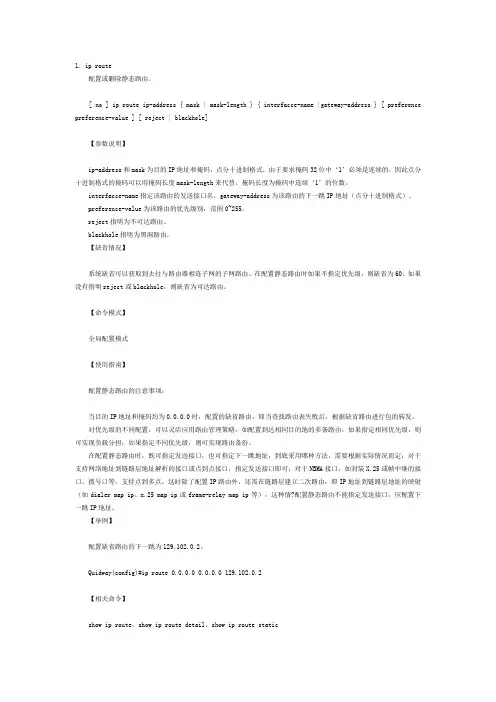
1. ip route配置或删除静态路由。
[ no ] ip route ip-address { mask | mask-length } { interfacce-name |gateway-address } [ preference preference-value ] [ reject | blackhole]【参数说明】ip-address和mask为目的IP地址和掩码,点分十进制格式,由于要求掩码32位中‘1’必须是连续的,因此点分十进制格式的掩码可以用掩码长度mask-length来代替,掩码长度为掩码中连续‘1’的位数。
interfacce-name指定该路由的发送接口名,gateway-address为该路由的下一跳IP地址(点分十进制格式)。
preference-value为该路由的优先级别,范围0~255。
reject指明为不可达路由。
blackhole指明为黑洞路由。
【缺省情况】系统缺省可以获取到去往与路由器相连子网的子网路由。
在配置静态路由时如果不指定优先级,则缺省为60。
如果没有指明reject或blackhole,则缺省为可达路由。
【命令模式】全局配置模式【使用指南】配置静态路由的注意事项:当目的IP地址和掩码均为0.0.0.0时,配置的缺省路由,即当查找路由表失败后,根据缺省路由进行包的转发。
对优先级的不同配置,可以灵活应用路由管理策略,如配置到达相同目的地的多条路由,如果指定相同优先级,则可实现负载分担;如果指定不同优先级,则可实现路由备份。
在配置静态路由时,既可指定发送接口,也可指定下一跳地址,到底采用哪种方法,需要根据实际情况而定:对于支持网络地址到链路层地址解析的接口或点到点接口,指定发送接口即可;对于NBMA接口,如封装X.25或帧中继的接口、拨号口等,支持点到多点,这时除了配置IP路由外,还需在链路层建立二次路由,即IP地址到链路层地址的映射(如dialer map ip、x.25 map ip或frame-relay map ip等),这种情?配置静态路由不能指定发送接口,应配置下一跳IP地址。
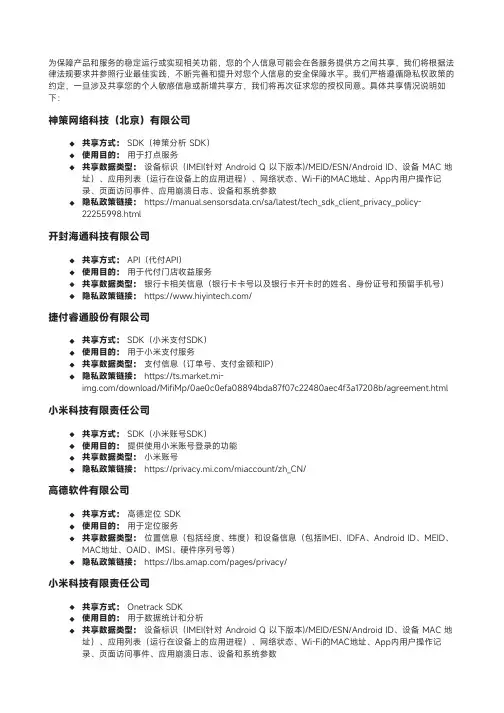

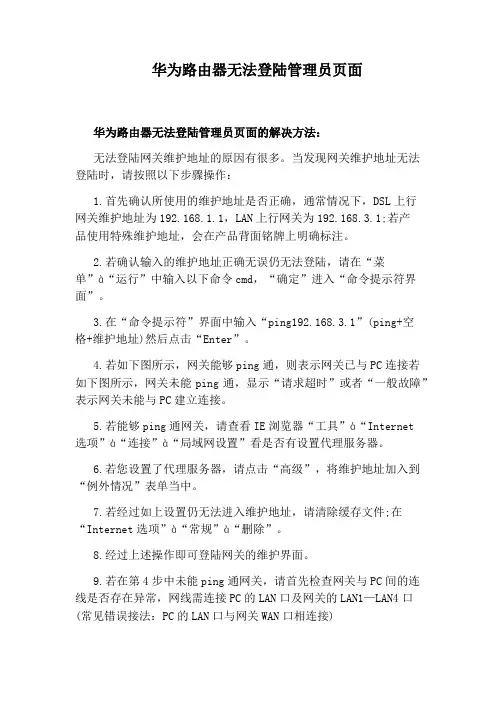
华为路由器无法登陆管理员页面华为路由器无法登陆管理员页面的解决方法:无法登陆网关维护地址的原因有很多。
当发现网关维护地址无法登陆时,请按照以下步骤操作:1.首先确认所使用的维护地址是否正确,通常情况下,DSL上行网关维护地址为192.168.1.1,LAN上行网关为192.168.3.1;若产品使用特殊维护地址,会在产品背面铭牌上明确标注。
2.若确认输入的维护地址正确无误仍无法登陆,请在“菜单”à“运行”中输入以下命令cmd,“确定”进入“命令提示符界面”。
3.在“命令提示符”界面中输入“ping192.168.3.1”(ping+空格+维护地址)然后点击“Enter”。
4.若如下图所示,网关能够ping通,则表示网关已与PC连接若如下图所示,网关未能ping通,显示“请求超时”或者“一般故障”表示网关未能与PC建立连接。
5.若能够ping通网关,请查看IE浏览器“工具”à“Internet选项”à“连接”à“局域网设置”看是否有设置代理服务器。
6.若您设置了代理服务器,请点击“高级”,将维护地址加入到“例外情况”表单当中。
7.若经过如上设置仍无法进入维护地址,请清除缓存文件;在“Internet选项”à“常规”à“删除”。
8.经过上述操作即可登陆网关的维护界面。
9.若在第4步中未能ping通网关,请首先检查网关与PC间的连线是否存在异常,网线需连接PC的LAN口及网关的LAN1—LAN4口(常见错误接法:PC的LAN口与网关WAN口相连接)10.若连接无异常,仍无法登陆维护页面,请联系运营商,送修维修代理。
看过文章“华为路由器无法登陆管理员页面”的人还看了:。
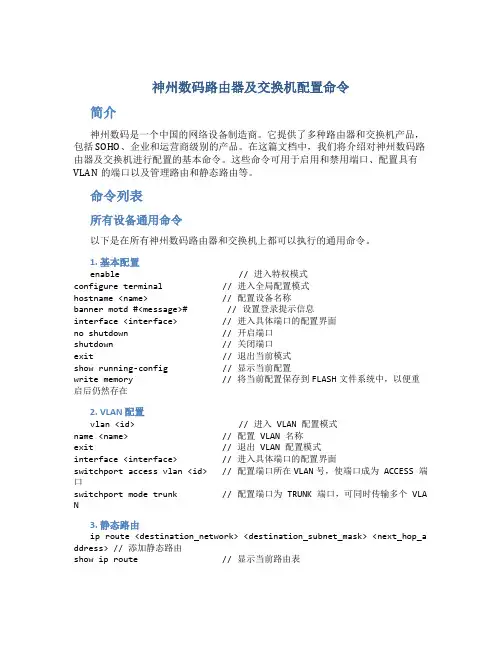
神州数码路由器及交换机配置命令简介神州数码是一个中国的网络设备制造商。
它提供了多种路由器和交换机产品,包括SOHO、企业和运营商级别的产品。
在这篇文档中,我们将介绍对神州数码路由器及交换机进行配置的基本命令。
这些命令可用于启用和禁用端口、配置具有VLAN的端口以及管理路由和静态路由等。
命令列表所有设备通用命令以下是在所有神州数码路由器和交换机上都可以执行的通用命令。
1. 基本配置enable // 进入特权模式configure terminal // 进入全局配置模式hostname <name> // 配置设备名称banner motd #<message># // 设置登录提示信息interface <interface> // 进入具体端口的配置界面no shutdown // 开启端口shutdown // 关闭端口exit // 退出当前模式show running-config // 显示当前配置write memory // 将当前配置保存到FLASH文件系统中,以便重启后仍然存在2. VLAN 配置vlan <id> // 进入 VLAN 配置模式name <name> // 配置 VLAN 名称exit // 退出 VLAN 配置模式interface <interface> // 进入具体端口的配置界面switchport access vlan <id> // 配置端口所在VLAN号,使端口成为 ACCESS 端口switchport mode trunk // 配置端口为 TRUNK 端口,可同时传输多个 VLA N3. 静态路由ip route <destination_network> <destination_subnet_mask> <next_hop_a ddress> // 添加静态路由show ip route // 显示当前路由表某些设备具有的高级命令以下命令在某些神州数码路由器和交换机上可用。
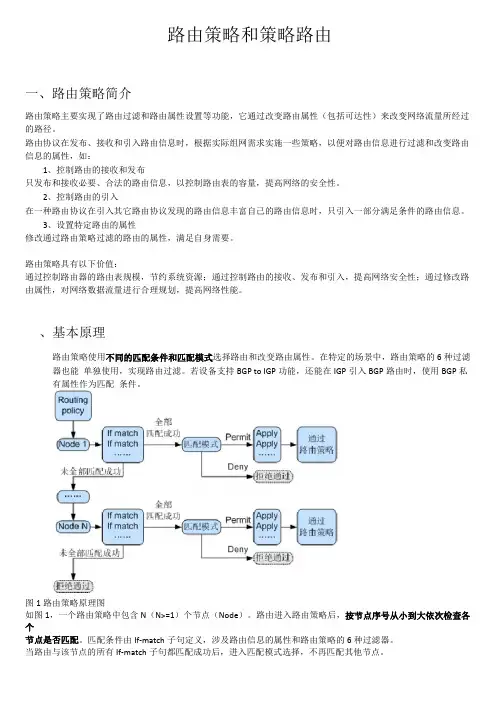
路由策略和策略路由一、路由策略简介路由策略主要实现了路由过滤和路由属性设置等功能,它通过改变路由属性(包括可达性)来改变网络流量所经过的路径。
路由协议在发布、接收和引入路由信息时,根据实际组网需求实施一些策略,以便对路由信息进行过滤和改变路由信息的属性,如:1、控制路由的接收和发布只发布和接收必要、合法的路由信息,以控制路由表的容量,提高网络的安全性。
2、控制路由的引入在一种路由协议在引入其它路由协议发现的路由信息丰富自己的路由信息时,只引入一部分满足条件的路由信息。
3、设置特定路由的属性修改通过路由策略过滤的路由的属性,满足自身需要。
路由策略具有以下价值:通过控制路由器的路由表规模,节约系统资源;通过控制路由的接收、发布和引入,提高网络安全性;通过修改路由属性,对网络数据流量进行合理规划,提高网络性能。
、基本原理路由策略使用不同的匹配条件和匹配模式选择路由和改变路由属性。
在特定的场景中,路由策略的6种过滤器也能单独使用,实现路由过滤。
若设备支持BGP to IGP功能,还能在IGP引入BGP路由时,使用BGP私有属性作为匹配条件。
图1路由策略原理图如图1,一个路由策略中包含N(N>=1)个节点(Node)。
路由进入路由策略后,按节点序号从小到大依次检查各个节点是否匹配。
匹配条件由If-match子句定义,涉及路由信息的属性和路由策略的6种过滤器。
当路由与该节点的所有If-match子句都匹配成功后,进入匹配模式选择,不再匹配其他节点。
匹配模式分permit和deny两种:permit:路由将被允许通过,并且执行该节点的Apply子句对路由信息的一些属性进行设置。
deny:路由将被拒绝通过。
当路由与该节点的任意一个If-match子句匹配失败后,进入下一节点。
如果和所有节点都匹配失败,路由信息将被拒绝通过。
过滤器路由策略中If-match子句中匹配的6种过滤器包括访问控制列表ACL(Access Control List)、地址前缀列表、AS路径过滤器、团体属性过滤器、扩展团体属性过滤器和RD属性过滤器。
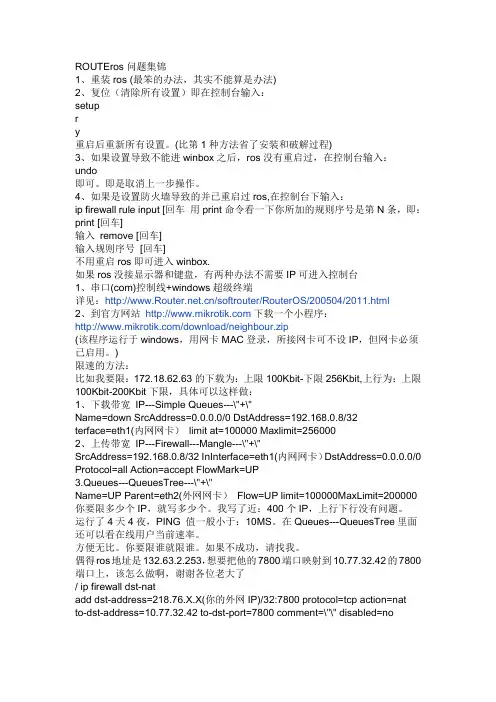
ROUTEros问题集锦1、重装ros (最笨的办法,其实不能算是办法)2、复位(清除所有设置)即在控制台输入:setupry重启后重新所有设置。
(比第1种方法省了安装和破解过程)3、如果设置导致不能进winbox之后,ros没有重启过,在控制台输入:undo即可。
即是取消上一步操作。
4、如果是设置防火墙导致的并已重启过ros,在控制台下输入:ip firewall rule input [回车用print命令看一下你所加的规则序号是第N条,即:print [回车]输入remove [回车]输入规则序号[回车]不用重启ros即可进入winbox.如果ros没接显示器和键盘,有两种办法不需要IP可进入控制台1、串口(com)控制线+windows超级终端详见:/softrouter/RouterOS/200504/2011.html2、到官方网站下载一个小程序:/download/neighbour.zip(该程序运行于windows,用网卡MAC登录,所接网卡可不设IP,但网卡必须已启用。
)限速的方法:比如我要限:172.18.62.63的下载为:上限100Kbit-下限256Kbit,上行为:上限100Kbit-200Kbit下限,具体可以这样做:1、下载带宽IP---Simple Queues---\"+\"Name=down SrcAddress=0.0.0.0/0 DstAddress=192.168.0.8/32terface=eth1(内网网卡)limit at=100000 Maxlimit=2560002、上传带宽IP---Firewall---Mangle---\"+\"SrcAddress=192.168.0.8/32 InInterface=eth1(内网网卡)DstAddress=0.0.0.0/0 Protocol=all Action=accept FlowMark=UP3.Queues---QueuesTree---\"+\"Name=UP Parent=eth2(外网网卡)Flow=UP limit=100000MaxLimit=200000 你要限多少个IP,就写多少个。
HUAWEI B315s-22 LTE CPE V200R001Product Description Issue 01Date 2014-12-15Copyright © Huawei Technologies Co., Ltd. 2014. All rights reserved.No part of this document may be reproduced or transmitted in any form or by any means without prior written consent of Huawei Technologies Co., Ltd.Trademarks and Permissionsand other Huawei trademarks are trademarks of Huawei Technologies Co., Ltd.All other trademarks and trade names mentioned in this document are the property of their respective holders.NoticeThe purchased products, services and features are stipulated by the contract made between Huawei and the customer. All or part of the products, services and features described in this document may not be within the purchase scope or the usage scope. Unless otherwise specified in the contract, all statements, information, and recommendations in this document are provided "AS IS" without warranties, guarantees or representations of any kind, either express or implied.The information in this document is subject to change without notice. Every effort has been made in the preparation of this document to ensure accuracy of the contents, but all statements, information, and recommendations in this document do not constitute a warranty of any kind, express or implied. Huawei Technologies Co., Ltd.Address: Huawei Industrial BaseBantian, LonggangShenzhen 518129People's Republic of ChinaWebsite: /en/Email: *****************About This Document SummaryThis document provides information for product features, main functions and services,technical specifications and technical references.This document includes:Chapter Details1 Product Overview Describes the appearance and main services of product2 Features Describes the product features3 Technical Specifications Describes the specifications of product hardware,software and user interface4 Services and Applications Describes the main functions and applications5 System Structure Describes the product system structure6 Packing List Describes the devices and accessories of the productThe document is an invitation to offer but not an offer. It is intended to describe the general features andfunctions of products. The features and functions of certain products vary with requirements ofcustomers.HistoryIssue Date Details01 2014-12-15 Initial official release.ContentsAbout This Document (ii)1 Product Overview (1)2 Features (3)3 Technical Specifications (4)3.1 Hardware Specifications (4)3.2 Antenna and Radio Frequency Specifications (6)3.3 Software Specifications (8)4 Services and Applications (11)4.1 Data Services (11)4.1.1 Accessing the Internet Through a Mobile Network (LTE/UMTS/GSM) (11)4.1.2 Accessing the Internet Through an Ethernet Network (12)4.2 V oice Services (12)4.3 SMS (13)4.4 Security Service (13)4.5 USB Sharing services (13)4.6 Local management and maintenance (13)5 System Structure (14)5.1 System Architecture Diagram (14)5.2 Functional Modules (14)6 Packing List (15)A Acronyms and Abbreviations (16)1 Product Overview The HUAWEI B315s-22 LTE CPE (B315s-22 for short) is a wireless gateway that integrates LTE and high-speed Ethernet uplink access, which provides users with flexible and diversified data access and voice services.The frequency bands of the product are as follows.●LTE: Band 1/3/7/8/20/38FDD 2100 MHz/1800 MHz/2600 MHz/900 MHz/800 MHz/TDD 2600 MHz●UMTS: Band 1/8 2100 MHz/900 MHz●GSM: Band 2/3/5/8 1900 MHz/1800 MHz/850 MHz/900 MHzThe B315s-22 supports the following standards:●Long Term Evolution (LTE)●Dual Carrier High Speed Packet Access Plus (DC-HSPA+)●High Speed Packet Access Plus (HSPA+)●High Speed Packet Access (HSPA)●Wideband Code Division Multiple Access (WCDMA)●Enhanced Data Rates for Global Evolution (EDGE)●General Packet Radio Service (System) (GPRS)●Global System for Mobile Communications (GSM)●Gigabit Ethernet (GE)The B315s-22 supports wired and wireless network access, and provides data routing service. The B315s-22 provides the following services:●Data service●Voice service●SMS●Security service●Local maintenance management functionFigure 1-1B315s-22 appearance2 FeaturesThe B315s-22 mainly supports the following features:●Access to LTE/DC-HSPA+/HSPA+/HSPA/WCDMA/EDGE/GPRS/GSM wirelessnetworks●Access to Gigabit Ethernet networks●High-speed data access−LTE FDD: DL 150 Mbps, UL 50 Mbps−LTE TDD: DL 112 Mbps, UL 10 Mbps−DC-HSPA+: DL 42 Mbps, UL 5.76 Mbps−HSPA+: DL 21 Mbps (64QAM) / 28 Mbps (MIMO), UL 5.76 Mbps−HSPA: DL 14.4 Mbps, UL 5.76 Mbps−WCDMA PS: 384 kbps−EDGE: DL 296 kbps, UL 236.8 kbps−GPRS: 85.6 kbps●Support maximum data transmission rate of 300 Mbps 802.11b/g/n●Compatibility with RJ11 telephone ports; can be set to V oice over Internet Protocol(V oIP) or Circuit Switch (CS) voice mode●USB 2.0 host port●External antenna port●Support for HUAWEI Mobile WiFi App●WPS 2.0●HOTA updates●Built-in DHCP Server, DNS RELAY and NAT●Security services. Provides instant protection to block potential security risks andintrusion attempts●Windows 8.1, Windows 8, Windows 7, Windows Vista SP1/SP2, Windows XP SP3, andMac OS X 10.9, 10.8, and 10.7 with latest upgrades●User-friendly design of LED indicator. Easy to observe the status of equipment.3 Technical Specifications 3.1 Hardware SpecificationsTable 3-1Technical specifications of the B315s-22 main unitItem DescriptionTechnical standard WAN ●Mobile Network:LTE/DC-HSPA+/HSPA+/HSPA/WCDMA/EDGE/GPRS/GSM●Gigabit Ethernet: IEEE 802.3/802.3uLAN IEEE 802.3/802.3uWLAN IEEE 802.11b/g/nWorking frequency band LTE Band 1/3/7/8/20/38FDD 2100 MHz/1800 MHz/2600 MHz/900 MHz/800MHz/TDD 2600 MHzUMTS Band 1/8 2100 MHz/900 MHzGSM Band 2/3/5/8 1900 MHz/1800 MHz/850 MHz/900 MHz WLAN 2.400 GHz - 2.474 GHzExternal port ●One power adapter port●Three LAN ports (RJ45)●One WAN/LAN port (RJ45)●One USB 2.0 host port●One phone port (RJ11)●Two external antenna ports●One SIM card slotItem DescriptionIndicator ●One power indicator●One Internet status indicator●One Wi-Fi/WPS indicator●One LAN indicator●One group of signal strength indicators Button ●One Power ON or OFF switch●One WPS button●One Reset buttonMaximum transmit power LTE Conform to 3GPP Power Class 3 DefinitionUMTS 23 dBm (+2 dB/-2 dB)GSM ●850 MHz/900 MHz: 33 dBm (+2 dB/-2 dB)●1800MHz/1900MHz: 30 dBm (+2 dB/-2 dB) WLAN 802.11b 16 dBm(+3 dB/-3 dB)@11 Mbps 802.11g ●17 dBm(+3 dB/-3 dB)@6 Mbps●17 dBm(+3 dB/-3 dB)@54 Mbps802.11n ●17 dBm(+3 dB/-3 dB)@MCS0●17 dBm(+3 dB/-3 dB)@MCS7Receiving sensitivity LTE Conform to 3GPP DefinitionUMTS ●2100MHz:*****************●900MHz:***************** GSM -104 dBmWLAN 802.11b ≤ -92 dBm@1 Mbps≤ -85 dBm@11 Mbps 802.11g ≤ -88 dBm@6 Mbps≤ -70 dBm@54 Mbps 802.11n HT20 ≤ -88 dBm@MCS0≤ -68 dBm@MCS7802.11n HT40 ≤ -84 dBm@MCS0≤ -66 dBm@MCS7Power consumption< 12 WAC/DC power supply ●AC: 100 V - 240 V ●DC: 12 V/1 ADimensions(Maximum)186 mm (Width) x 139 mm (High) x 46 mm (Deep)Item DescriptionWeight About 275 g (excluding the power adapter)Temperature ●Working temperature: 0°C to 40°C●Storage temperature: -20°C to +70°CHumidity 5% - 95%3.2 Antenna and Radio Frequency SpecificationsTable 3-2L TE/UMTS/GSM main diversity antenna specificationsItem DescriptionFrequency ●703 MHz - 960 MHz●1710 MHz - 2690 MHzInput50 ΩimpedanceStanding wave< 3ratioEfficiency ≥ -4.5 dB@703MHz - 960MHz≥ -3.5 dB@1710MHz - 2690MHzH side gain ≥ 1 dBi (horizontal level)Polarization Linear polarizationTable 3-3L TE/UMTS sub diversity antenna specificationsItem DescriptionFrequency ●703 MHz - 960 MHz●1710 MHz - 2690 MHzInput50 ΩimpedanceStanding wave< 3ratioEfficiency ≥ -4.5 dB@703MHz - 960MHz≥ -3.5 dB@1710MHz - 2690MHzH side gain ≥ 1 dBi (horizontal level)Polarization Linear polarizationTable 3-4WLAN 2.4 GHz antenna specificationsItem DescriptionFrequency 2.400 GHz - 2.474 GHzInput50 ΩimpedanceStanding wave< 2ratioEfficiency ≥ -3 dBH side gain ≥ 1 dBi (horizontal level)Polarization Linear polarizationTable 3-5External antenna specifications●The external antenna is an optional accessory. Signals may be weak in some areas; thus, you canchoose whether to use the external antenna.●The external antenna can be used indoor only. Put it near the window when using to get better signal.●Avoid thunderstorms when using.Item DescriptionTechnicalLTE/DC-HSPA+/HSPA+/HSPA/WCDMA/EDGE/GPRS/GSM standardFrequency ●703 MHz - 960 MHz●1710 MHz - 2690 MHzInput50 ΩimpedanceStanding wave< 3ratioH side gain ≥ 3 dBi (horizontal level)Polarization Linear polarizationInterfaceSMA-J1.5standard3.3 Software SpecificationsTable 3-6Software specificationsItem DescriptionMobile network APN managementGigabit Ethernet ●WAN/LAN auto-negotiation●PPPoE username and passwordData service LTE FDD DL 150 Mbps, UL 50 MbpsLTE TDD ●Configuration 1: DL 80 Mbps, UL 20 Mbps●Configuration 2: DL 112 Mbps, UL 10 MbpsDC-HSPA+ DL 42 Mbps, UL 5.76 MbpsHSPA+ DL 21 Mbps (64QAM) / 28 Mbps (MIMO)UL 5.76 MbpsHSPA DL 14.4 Mbps, 10.2 Mbps, 7.2 Mbps, 3.6 MbpsUL 5.76 Mbps, 2 MbpsWCDMA PS DL 384 kbps, UL 384 kbpsEDGE DL 296 kbps, UL 236.8 kbps (depending on thenetwork configuration)GPRS DL 85.6 kbps, UL 85.6 kbps (depending on thenetwork configuration)WLAN ●802.11b: 11 Mbps, 5.5 Mbps, 2 Mbps, 1 Mbps●802.11g: 54 Mbps, 48 Mbps, 36 Mbps, 24 Mbps,18 Mbps, 12 Mbps, 9 Mbps, 6 Mbps●802.11n: 300 Mbps (HT40 MCS15), 144.4 Mbps(HT20 MCS15)Web management Web management pageAccess to the web management page through an IPv4 addressWeb browser ●IE 8.0 (Windows XP)●IE 8.0 and above (Windows 7/Vista)●IE 10.0 and above (Windows 8)●Firefox 24.0 and above●Safari 6.0 and above (MAC)●Opera 12.0 and above●Chrome 27.0 and aboveItem DescriptionGateway Router Default routing (the routing address is 0.0.0.0). Youcan set the WAN connection to the default routing togenerate default routing table itemsDHCP Server ●The default gateway address is 192.168.8.1●The default IP addresses of the DHCP server isfrom 192.168.8.100 to 192.168.8.254. The IPaddresses can be customized.●The default DHCP lease is 24 hours●The DHCP Server can be enabled or disabled ●The address pool of the DHCP server can beconfigured●The lease can be configuredNAT ●NAT, NAPT (compliant with RFC2663, RFC3022and RFC3027)●CONE NAT●Fragment message identification for normal NAT●ALGARPICMPDNS RelayIPv6/IPv4 dual stackSMS Writing, sending, and receiving messagesVoice service (Alternatively) VoIP voice ●SIP voice services●G.722/G.711a/G.711u/G.729/G.726 encoding anddecodingCS voice ●CS voice services over UMTS/GSM networks●CSFBFirewall setup Firewall switchURL filterVirtual serverPort forwardingPort triggeringDMZ serviceALG settingsRemote managementLAN 10 Mbps, 100 Mbps, and 1000 Mbps auto-negotiationItem DescriptionMDI/MDIX auto-sensingIEEE 802.3/802.3u is compatibleWLAN IEEE 802.11b/g/n4 SSID broadcast and hiding are supported in maximum.WPS 2.0WMMEncryption ●WEP●AES●TKIP+AESSecurity mode ●WPA2.0 PSK●WPA1.0/WPA2.0 PSK●WEP Shared Key (four keys at most)●OpenMAC address authentication ●White list●Black list●The preceding two lists cannot coexist ●Up to 10 MAC address itemsSTA management ●Supports inquiry of STA status●Supports limit of access users (Access fromup to 32 users)HUAWEI Mobile WiFi App View service provider's name, the roaming status and signal strength. View the data traffic usage and SMS.Manage the connected devices.Change SSID and password.System requirement Windows 8.1, Windows 8, Windows 7, Windows Vista SP1/SP2, Windows XP SP3, and Mac OS X 10.9, 10.8, and 10.7 with latest upgradesYour computer's hardware system should meet or exceed the recommended system requirements for the installed version of OS4 Services and Applications 4.1 Data ServicesThe B315s-22 can access the Internet through mobile networks, and Ethernet networks. Byconnecting to the B315s-22 using Wi-Fi or a network cable, users can get access tohigh-speed Internet services and establish a local area network (LAN).4.1.1 Accessing the Internet Through a Mobile Network(LTE/UMTS/GSM)The B315s-22 can access the Internet through mobile networks.Figure 4-1Accessing the Internet through a mobile network4.1.2 Accessing the Internet Through an Ethernet NetworkConnect the B315s-22's WAN/LAN port to a wall-mounted Ethernet port using a networkcable.Figure 4-2Accessing the Internet through an Ethernet network4.2 Voice ServicesThe B315s-22 provides one telephone port that can be connected to telephones for calling.Figure 4-3Connecting telephones to the B315s-224.3 SMSThe B315s-22 supports message writing/sending/receiving and group sending (up to 50contacts at a time). You can manage messages through the Web page, such as inbox, outbox,draft.4.4 Security ServiceThe B315s-22 supports various security features, such as the firewall, user authentication, andPIN protection, protect users against security threats from the Internet when users are usingnetwork services.4.5 USB Sharing servicesWith one USB port, users can connect a USB storage device to the USB port on the B315s-22to save and share files. Users can also connect a USB printer to the USB port on the B315s-22for printing services.Figure 4-4Connecting USB devices to the B315s-224.6 Local management and maintenanceThe B315s-22 supports local configuration through the Web page. You can accomplish devicemanagement, network configuration and ensure normal and stable performance.5 System Structure 5.1 System Architecture DiagramFigure 5-1System architecture5.2 Functional Modules●Mobile network access: The B315s-22 adopts the LTE/UMTS/GSM access technology atthe WAN side, can access the wireless broadband packet-based.●WLAN AP function: 802.11b/g/n compliant WLAN AP interface is provided, used forwireless networking at home. The interface is compliant with the IEEE 802.11b/g/nstandard and the WPA-PSK/WPA2-PSK/WEP security authentication.●DHCP/DNS: The DHCP server dynamically allocates IP addresses to PCs. The DNSparses domain names.●Web management: You can configure, modify and query the configuration information ofthe B315s-22.●Routing and NA T: High-speed routing capability. With the built-in NA T, the B315s-22,together with wireless broadband packet-based network devices, can provide flexiblebroadband access solutions and networking schemes.6 Packing List Table 6–1 shows the devices and accessories of the B315s-22.Table 6-1Packing listDescription Quantity RemarksWireless Gateway 1 StandardPower supply adapter 1 StandardQuick Start 1 StandardEthernet cable 1 StandardWarranty card 1 OptionalPhone cable 1 OptionalHUAWEI B315s-22 wireless gateway also provide external antenna as optional for you to choose.HUAWEI B315s-22 LTE CPEProduct Description A Acronyms and AbbreviationsA Acronyms and AbbreviationsAAC Alternating CurrentARP Address Resolution ProtocolAP Access PointAPN Access Point NameCCPE Customer Premises EquipmentCS Circuit SwitchCSFB Circuit Switched FallbackDDHCP Dynamic Host Configuration ProtocolDL DownlinkDNS Domain Name ServerGGE Gigabit EthernetHHSPA High Speed Packet AccessHSPA+ High Speed Packet Access PlusHSDPA High Speed Downlink Packet AccessHSUPA High Speed Uplink Packet AccessHT High ThroughputIIP Internet ProtocolHUAWEI B315s-22 LTE CPEProduct Description A Acronyms and AbbreviationsIssue 01 (2014-12-15) Huawei Proprietary and ConfidentialCopyright © Huawei Technologies Co., Ltd. 17ICMP Internet Control Message ProtocolLLAN Local Area NetworkLED Light Emitting DiodeLTE Long Term EvolutionMMCS Modulation and Coding SchemeNNAT Network Address TranslationPPOTS Plain Old Telephone ServiceTTKIP Temporal Key Integrity ProtocolUUMTS Universal Mobile Telecommunications System UL UplinkVVoIP Voice over Internet ProtocolWWAN Wide Area NetworkWLAN Wireless Local Area NetworkWCDMA Wideband Code Division Multiple AccessWi-Fi Wireless Fidelity。
react获取菜单一级路由信息的方法React是一种由Facebook开发的JavaScript库,用于构建用户界面。
它的简洁性、高效性和易用性使其成为创建可交互的前端应用程序的首选工具。
在React中,我们可以使用一些方法来获取菜单的一级路由信息,以便我们可以更好地管理和呈现我们的应用程序菜单。
在React中,我们通常使用路由来管理应用程序的导航。
React Router是一个专门用于处理应用程序路由的库。
通过使用React Router,我们可以定义不同的路由和组件,从而实现应用程序的导航效果。
下面是一种常用的方法来获取菜单的一级路由信息:1.首先,我们需要安装并导入React Router库。
你可以使用`npm`或`yarn`来安装它。
安装完成后,我们可以在代码中导入所需的组件和方法。
```javascriptimport{BrowserRouter as Router,Route,Link}from'react-router-dom';```2.然后,我们可以创建一个菜单组件,并在其内部定义我们的一级路由。
我们可以使用`Route`组件来定义每个路由。
```javascriptconst MainMenu=()=>{return(<Router><div><ul><li><Link to="/">主页</Link></li><li><Link to="/about">关于我们</Link></li><li><Link to="/contact">联系我们</Link></li></ul><hr/><Route exact path="/"component={Home}/><Route path="/about"component={About}/><Route path="/contact"component={Contact}/> </div></Router>);};```在这个例子中,我们创建了一个主菜单,并定义了三个一级路由:主页、关于我们和联系我们。
路由表说明(详解routeprint)看了nello的路由表,就找来这片文章,比较详细的解释了路由表,这个还是比较常用的,和大家共享路由表说明-------------------------------------------------------------源码:----------------------------------------------------------Active Routes:Network Destination Netmask Gateway Interface Metric0.0.0.0 0.0.0.0 192.168.123.254 192.168.123.8810.0.0.0 0.0.0.0 192.168.123.254 192.168.123.681127.0.0.0 255.0.0.0 127.0.0.1 127.0.0.1 1192.168.123.0 255.255.255.0 192.168.123.68 192.168.123.681192.168.123.0 255.255.255.0 192.168.123.88 192.168.123.881192.168.123.6 8 255.255.255.255127.0.0.1 127.0.0.1 1192.168.123.8 8 255.255.255.255127.0.0.1 127.0.0.1 1192.168.123.2255.255.255.2192.168.123.6192.168.123. 155 55 8 68192.168.123.2 55 255.255.255.255192.168.123.88192.168.123.881224.0.0.0 224.0.0.0 192.168.123.68 192.168.123.681224.0.0.0 224.0.0.0 192.168.123.88 192.168.123.881255.255.255.2 55 255.255.255.255192.168.123.68192.168.123.681Default Gateway: 192.168.123.254---------------------------------------------------------------------------------------------------------------------------当前的路由:destination目的网段mask子网掩码interface到达该目的地的本路由器的出口ipgateway 下一跳路由器入口的ip,路由器通过interface和gateway定义一调到下一个路由器的链路,通常情况下,interface和gateway是同一网段的metric 跳数,该条路由记录的质量,一般情况下,如果有多条到达相同目的地的路由记录,路由器会采用metric值小的那条路由第一条缺省路由:意思就是说,当一个数据包的目的网段不在你的路由记录中,那么,你的路由器该把那个数据包发送到哪里!缺省路由的网关是由你的连接上的default gateway决定的该路由记录的意思是:当我接收到一个数据包的目的网段不在我的路由记录中,我会将该数据包通过192.168.123.88这个接口发送到192.168.123.254这个地址,这个地址是下一个路由器的一个接口,这样这个数据包就可以交付给下一个路由器处理,与我无关。
鸿蒙系统单页面路由
页面之间跳转是由系统接口通过Ability进行跳转的,所以它不是简单的页面hash路由,而是通过FA的方式进行路由跳转的。
注意:页面路由需要在页面渲染完成之后才能调用,在onInit和onReady生命周期中页面还处于渲染阶段,禁止调用页面路由方法。
下面具体介绍页面路由的使用步骤。
导入模块的代码如下:
1.路由方法
router.push(OBJECT)跳转到应用内的指定页面,如代码示例1所示。
代码示例1 router.push
2.router.replace(OBJECT)
用应用内的某个页面替换当前页面,并销毁被替换的页面,如代码示例2所示。
代码示例2 router.replace
3.router.back(OBJECT)
返回上一页面或指定的页面,如代码示例3所示。
代码示例3 router.back
4.router.clear()
清空页面栈中的所有历史页面,仅保留当前页面作为栈顶页面,代码如下:
5.router.getLength()
获取当前页面栈内的页面数量,代码如下:
6.router.getState()
获取当前页面的状态信息,代码如下:
2 多页面路由
我们可以创建多个Ability,多个Ability间的路由跳转,可以通过Java中的PA进行跳转。
解决Vue使⽤bus总线时,第⼀次路由跳转时数据没成功传递问题bus总线是vue中路由跳转传递数据的常⽤⽅法,适⽤于传递数据不多的情况,但是在使⽤的过程中发现,bus总线在第⼀次路由跳转的时候总是不能够成功传递需要传递的数据。
检查bus的配置以及调⽤⽅法,均没有出错,错就错在没有理解Vue的⽣命周期我们知道bus的$on的监听应该位于$emit之前,如果在emit之前没有创建监听事件,那么肯定是得不到需要的数据。
因此,我通过两个页⾯来了解路由跳转时两个页⾯的⽣命周期,下⾯给出其中⼀个页⾯的部分代码://页⾯1beforeCreate () {console.group('%c%s', 'color:red', 'beforeCreate 创建前状态===============组件1》')},created () {console.group('%c%s', 'color:red', 'created 创建完毕状态===============组件1》')},beforeMount () {console.group('%c%s', 'color:red', 'beforeMount 挂载前状态===============组件1》')},mounted () {console.group('%c%s', 'color:red', 'mounted 挂载状态===============组件1》')},beforeUpdate () {console.group('%c%s', 'color:red', 'beforeUpdate 更新前状态===============组件1》')},updated () {console.group('%c%s', 'color:red', 'updated 更新状态===============组件1》')},beforeDestroy () {console.group('%c%s', 'color:red', 'beforeDestroy 破前状态===============组件1》')},destroyed () {console.group('%c%s', 'color:red', 'destroyed 破坏状态===============组件1》')}当从页⾯1跳转到页⾯2的时候,控制台的打印情况如下:从上图便可以发现,bus第⼀次使⽤⽆法传递的原因:在页⾯1通过$emit⽅法传递数据然后跳转路由的时候,其实页⾯2的$on监听还没有建⽴,因此⽆法得到数据!基于上述原因,提出的解决办法如下:在页⾯1的beforeDestroy或者destroyed钩⼦函数中emit数据,在页⾯2的beforeCreate、created或者beforeMount钩⼦函数中建⽴$on监听事件,然后在页⾯2的mounted钩⼦函数中$on得到的数据赋值给页⾯2的变量中。